|
July 2010 | Volume 2/Number 4
Feature Story
TDM Migration and the Path Toward Unified NetworksTips and best practices for how to migrate to a unified MPLS network It is common knowledge that telecommunication service providers worldwide
have transport networks that originally were designed to deliver TDM services. Yet due to the exponential growth in data services we have experienced over the past few years next-generation transport is facing scalability and cost challenges, and therefore embedding packet capabilities. The Current Status of TDM Traffic TDM services and SONET/SDH technologies were designed to deliver voice. Voice is a mandatory service with specific requirements, but its capacity in the entire network is very small – less than 10 percent in most cases. Most of the TDM services today are leased lines that enterprises consume to connect their remote offices. TDM is considered as a reliable and secure connection, and therefore it was widely adopted as a VPN enabler. The 155mbps that is achievable with an STM-1 connection is a popular example. The introduction of carrier-grade switches and routers brought an alternative with a much higher capacity and lower cost. The result was acceptance of Ethernet services for enterprise VPN and residential triple-play service. A closer look at the actual business that is deriving from the TDM leased lines reflects this trend – most of the TDM services are actually Ethernet-over-SDH services that are still producing good margins for the telecom service providers. But a combination of increased competition (a practical alternative for an enterprise to replace its STM-1 service with gigabit Ethernet service) with the exponential growth of packet services is changing the overall picture. A long-term view on the traffic that networks will need to deliver is clear – Ethernet is the growth engine, and Ethernet will capture most of the traffic in the next-generation networks. This is demonstrated in the below figure. 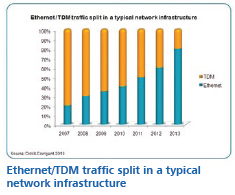 Thinking about TDM While the long-term vision regarding Ethernet and TDM is clear, implementation is affected by many constraints, including: current architecture and subscriber base, competition from alternative operators, regulation, required scalability, costs, workforce know-how, existing fiber and other factors. In some cases, TDM traffic and services are still growing. So a key question is how to enable the new TDM. Is it better to invest new TDM capex over the existing TDM network, or to devote new carrier Ethernet capex over the new carrier Ethernet network? This opens not only a capex and opex comparison, but also a strategic decision regarding one network that will handle all services vs. separated networks that will deliver different types of services. In other cases, TDM traffic and services are decreasing. This is mainly due to enterprises that are giving up their TDM and moving to Ethernet. A key question here is what to do with the existing TDM infrastructure. What is the best way to reuse the exiting subscribers, fibers and network infrastructure? 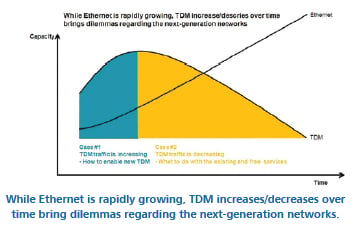 There also are various opex issues regarding the existing TDM network. Once again, the strategic decision here is about the co-existence
of both TDM and packet services in the next-generation network. This perspective
is demonstrated in the below figure. There also are various opex issues regarding the existing TDM network. Once again, the strategic decision here is about the co-existence
of both TDM and packet services in the next-generation network. This perspective
is demonstrated in the below figure.
TDM + Packet Networks: The Alternatives Service providers face the following alternatives and tradeoffs when designing their next-generation networks that should deliver both TDM and Ethernet services:  1. The Orthogonal Approach: Two Networks The orthogonal approach involves the addition of a new and parallel packet-based network to the already existing TDM network. In this concept, the service provider is maintaining two separate networks: one only for the TDM traffic and another one only for Ethernet traffic. Although this is the most intuitive and simple approach, it is not capex (network elements, fiber, etc.) or opex (human resources, customer support, etc.) effective. In addition, this approach is not satisfying the transport organization's motivation to embed packet technologies in its existing network. 2. The Overlay Approach: Ethernet over TDM The overlay approach involves backhauling of the upcoming Ethernet services over the existing TDM network. This is a starting point in networks that are heavily based on TDM infrastructure and are starting to offer Ethernet services. This is a costly alternative that is not reasonable for a large amount of Ethernet services, since it cannot take the advantage of statistical multiplexing. Therefore, a lot of unutilized ports will pass through the entire network to the expensive TDM and router core interfaces. 3. The Convergence Approach: MSPP/P-OTS The convergence approach is an all-inclusive approach, creating a converged networking layer including native support for TDM services and native support for packet services. This is being deployed by using MSPP/P-OTS products that implement a hybrid, complex and expensive fabric. A typical MSPP/P-OTS product embeds a wide variety of technologies, including DWDM, SONET/SDH and IP/Ethernet/MPLS. 4. The Migration Approach: Carrier Ethernet with Circuit Emulation The migration approach uses the standard and interoperable carrier Ethernet switches that were originally built for the delivery of large capacity packet services and adds circuit emulation technology to enable TDM services. The packetized TDM services are equivalent in their quality to those being provided by the traditional SDH/SONET networks. 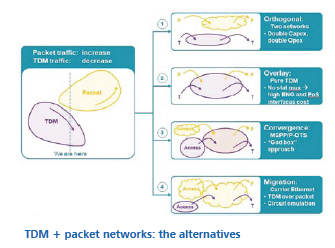 This approach
provides the opportunity for smooth migration from a TDM network to a packet network, since the TDM line cards can be added and removed at any time. This approach
provides the opportunity for smooth migration from a TDM network to a packet network, since the TDM line cards can be added and removed at any time.Migration vs. Convergence Migration and convergence are the two main alternatives for implementing next-generation networks. The migration concept is to move from "A" (TDM) to "B" (packet), while the convergence concept is to move from "A" (TDM) to "A" + "B" (TDM + packet). Typical migration products are carrier Ethernet switches that enable TDM with circuit emulation technologies, while typical convergence products are MSPP/P-OTS that have native TDM and native packet capabilities. The Migration Approach The migration approach is based on carrier Ethernet switches and routers. These products are based on a packet fabric and therefore can only perform packet processing. This means that for Ethernet services, the solution is highly scalable and cost optimized, but TDM services need to be packetized and handled specially by traffic management modules. The TDM traffic is transported on top of synchronization technologies (such as synchronous Ethernet and IEEE 1588v2) and TDM emulation protocols (such as CEP, SAToP and CESoP). This package enables any rate of TDM services – from E1 till STM-1/4/16 services. Other than scalability, performance and cost, the migration approach embeds TDM in optional line cards. This means that the service provider can add and remove the TDM line cards to cope with its current TDM traffic, without impacting the Ethernet performance. This pay-as-you-grow approach enables carrier Ethernet networks that will evolve to carry mainly packet services. TDM services being offered using circuit emulation technologies are equivalent in their behavior and quality to those being provided on the traditional SDH/SONET networks.  The Convergence Approach The convergence approach is based on MSPP/P-OTS products. These hybrid products pack the functionality of Ethernet and TDM on a single fabric and transp ort them in their native form. Therefore the products integrate smoothly into existing transport networks and provide satisfying solutions for networks that need to start introducing Ethernet services on their large capacity TDM infrastructure. MSPP/P-OTS product complexity is higher than a switch or a router since two different domains coexist – classic transport with DWDM and SDH, and classic packet with Ethernet/MPLS. Operating these platforms and debugging problems is a challenging task. In addition, since the long-term plan for the next-generation network is to support a massive amount of Ethernet services, and TDM is not optional on the products, this approach eventually will become non-competitive in its price point and performance to the pure switches and routers alternative. 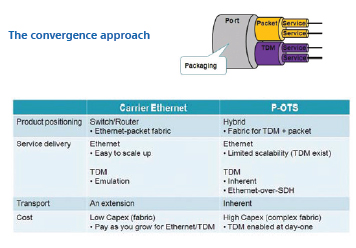 Smooth Operator While building the next-generation infrastructure, a gradual transition of TDM services enables a smooth network migration toward a unified packet network. The transition involves the following steps: Step 1: Building MPLS aggregation network and offloading high-capacity TDM traffic from the TDM backbone A typical starting point is a TDM network, based on PDH/SDH technologies, that enables both TDM services such as E1 and STM-1/4/16, as well as 10mbps/100mbps Ethernet services. 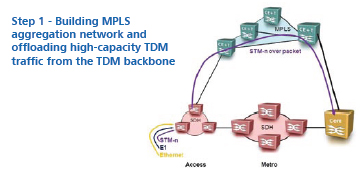 The first step is to build in parallel to the TDM metro network, a new carrier Ethernet network that will be used for metro aggregation.
This network is based on MPLS plus circuit emulation technologies.
At this step, the new network is used to carrying high-capacity TDM traffic that is coming from the access rings, and in doing so, offloading the TDM backbone. During this phase, the service provider also learns how to operate the new network and gains confidence with the new technologies and capabilities. The first step is to build in parallel to the TDM metro network, a new carrier Ethernet network that will be used for metro aggregation.
This network is based on MPLS plus circuit emulation technologies.
At this step, the new network is used to carrying high-capacity TDM traffic that is coming from the access rings, and in doing so, offloading the TDM backbone. During this phase, the service provider also learns how to operate the new network and gains confidence with the new technologies and capabilities.
Subscribers are not affected at this point, or in any other point of the migration. Step 2: Adding a multi-service access network to carry any service from the access network When the metro network is stable and robust, a new multi-service network is built in the access network. The multi-service network elements combine Ethernet and TDM interfaces and are used for both new and existing subscribers. This process is completing a new networking layer that is capable of carrying any type of service over packet. This network is scalable and cost optimized for the expected Ethernet traffic as well as capable of upgrading the existing subscribers to a higher capacity network with the same service level agreement. The new multi-service switches can be added as fast as the service provider needs. Step 3: Phasing out the TDM backbone while preserving the investment, subscribers and services in the TDM access At a certain point, most of the TDM traffic in the backbone already has migrated to the packet network, and therefore the TDM backbone is consuming opex that is higher than its revenues. In addition, the level of confidence and stability of the carrier Ethernet network is high. At this point, everything is ready to remove the TDM backbone. 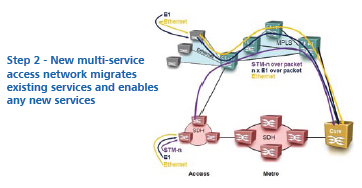 This significant step is to release the fiber that is used by the next-generation network, while preserving the very large number of network elements in the access network. Preserving the TDM installed base in the access is one of the most important achievements of the smooth migration, both economically and technically. Step 4: Completing the phased migration with a standard and interoperable carrier Ethernet network  The long-term vision for a unified network is achievable in a standard and interoperable way. The new carrier Ethernet network is scalable and has a high 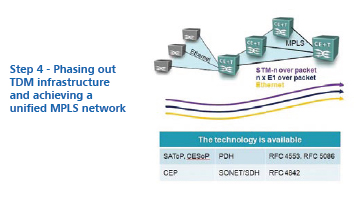 performance. The result is a network based on MPLS, and therefore the service provider is leveraging all of the technology's connection-oriented, traffic engineering, QoS, OAM and protection mechanisms. The circuit emulation technologies are also standard and available on today's networking platforms. Since circuit emulation was used, its line cards on the switches can be replaced with Ethernet line cards at any time without impacting the switching capacity. performance. The result is a network based on MPLS, and therefore the service provider is leveraging all of the technology's connection-oriented, traffic engineering, QoS, OAM and protection mechanisms. The circuit emulation technologies are also standard and available on today's networking platforms. Since circuit emulation was used, its line cards on the switches can be replaced with Ethernet line cards at any time without impacting the switching capacity. Eylon Sorek is associate vice president of marketing for Orckit- Corrigent (www.orckit.com). NGN Magazine Table of Contents |






